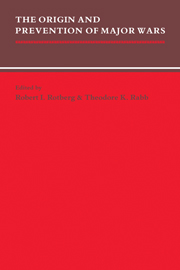Book contents
Crises and the Unexpected
Published online by Cambridge University Press: 02 December 2009
Summary
“A war nobody wanted” goes to the heart of a pathological puzzle that energizes our analyses of crises. Where nobody's interest is served, are we not required to lament and condemn all of the decision-making and policy processes that are involved? “War serves the interests of no one” has been a staple of many a sermon and commentary in the past; it is today an even more persuasive and plausible synopsis during any crisis that forces us to contemplate what modern weapons can do.
Thus, we will not treat a “crisis” simply as an enhanced likelihood of war, for this definition may be both too narrow and too broad. It may be too narrow in that it excludes the analogous family tensions and other human encounters where the worst each side can inflict on the other is far less than war, but where much of the same game of mutual risk-taking is at work. It may be too broad (even though much of popular usage might include all risks of war as crises) in that it draws in cases where no contest of wills is in place, and where neither side is betting its position on estimates of the other side's resolve. For example, if India loses its patience with the Portuguese and, minimizing costs all around in the process, tells its military to seize Goa, is the enhanced likelihood of war immediately prior to the seizure really a part of what we need to analyze in this article?
- Type
- Chapter
- Information
- The Origin and Prevention of Major Wars , pp. 127 - 146Publisher: Cambridge University PressPrint publication year: 1989



